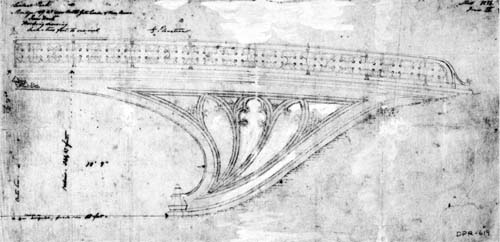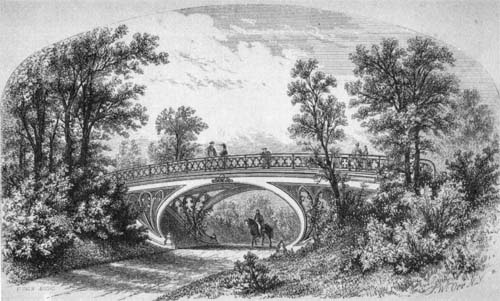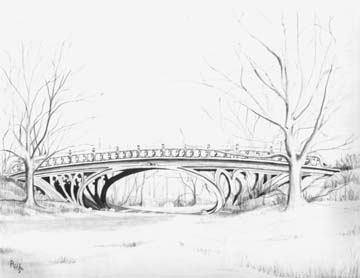This famous cast-iron bridge, designed by Calvert Vaux and erected near the north gatehouse of the Reservoir by 94th Street, was long known simply by number. Yet, it seemed somehow deserving of a name and has lately received one, appropriately, "Gothic Bridge."
The third of the cast-iron bridges around the Reservoir, like the other two, permits visitors to avoid crossing the bridle path. Equestrian traffic today hardly mandates the presence of the bridge, but it remains as a fanciful addition to the landscape, for the visitor's delight.
The cast-iron spandrels are developed like Gothic windows modified into windblown curves conforming to the oval contours of the arch. Floral crockets adorn the inside of the curves. Graceful and distinctive, the archway is 37 feet 5 inches at its widest point and reaches a height of 15 feet 3 inches. Gothic Bridge is 11 feet 7 inches wide and has a 93-foot railing. It was manufactured by the J. B. & W. W. Cornell Ironworks. The abutments are of Manhattan schist from the park.
Like so many other structures in the park, Gothic Bridge fell into disrepair. Before restoration could begin, successive stages of the 19th-century construction process had to be retraced. The careful, skilled work of the old foundrymen had to be examined and duplicated. Today's foundrymen had to check the old cast iron for flaws and repair it by grinding down the separate pieces into new crisp outlines.
Planning began in 1976, based on the nine surviving original drawings now at the Municipal Archives. New drawings were prepared by the Design Division of the Parks Department. Work was underway by 1981 and restoration was completed two years later.

Half elevation. Ironwork. Original working drawing. 1863.

"Archway under Foot-Path for Bridle Road, South of Meadows." Lithograph.
Seventh Annual Report, Central Park, for 1863.
| |
| |
|
| Previous page | |
Top of page | |
Next page |





